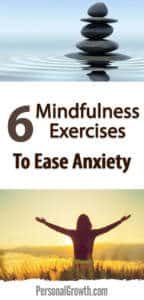

Anxiety is something that many people experience around the world. When this condition is left untreated, it can lower quality of life, reduce your productivity and even foster depression. Luckily, there are a lot of self-methods out there that can help ease anxiety, and one of these methods is the practice of mindfulness.
In general terms, when you are being mindful, you are paying attention to all your surroundings in a way that keeps you focused on the present. This helps give immediate relief to a person who has anxiety, as a lot of the stress associated with anxiousness is connected to dwelling on the past, worrying about the future or both.
While the effects of mindfulness on anxiety are easy to understand, it can be hard to figure out exactly how to apply the method to your daily life. Start off by trying the six mindfulness exercises below to help ease your anxiety and boost your life quality. These exercises can be done just about anywhere and will help you slow yourself down and to center in the present. They do not require any special equipment, are easy to learn and are suitable for even teenagers and children.
1. The Grounding
For the grounding exercise, you need to start off by standing up straight. You’ll need to keep good posture for this exercise without allowing your back to become stiff, so you may need to stretch a little first. Keep your feet shoulder-width apart, and let your arms hang loose by your sides. Don’t keep your arms tense, as the idea here is to let them hang freely. Your feet must be flat against the floor, so if you have heeled shoes on, take them off before doing this exercise. Now, close your eyes and take deep breaths slowly.
Once you have a deep breathing pattern set, move your attention to your body. Consider how your feet are firm and flat against the floor. Take some time flexing your toes, taking note of how the contraction of your muscles feels. Think about what is happening in your body, and really feel it. Imagine yourself being pulled right toward the Earth’s center, and also notice how much calmer you’re beginning to feel.
2. The Breathing
With breathing exercises, you are able to regulate how much carbon dioxide is in your blood, and this can help ease common anxiety and panic attack symptoms such as hyperventilation. Lie down, stand or sit in a position that you find comfortable and close your eyes. Inhale, and while you do, count to three. Then, exhale nice and slowly, counting to four while you’re doing it. Keep your focus on the feeling of the air entering your body and the sound of your inner voice while you count. This particular exercise can be difficult at first, but the better you get at it, the more relaxed you’ll be able to feel.
3. The Sensory Noticing Exercise
When you are anxious, you tend to miss what is right in front of you because you are lost in your negative thoughts and fears. The sensory noticing exercise helps bring you back to what’s around you.
Start by sitting down in a comfortable position, keeping your eyes open. Take some time to register all that you are feeling, hearing, tasting, smelling and seeing. Pay some attention to each and every piece of sensory information.
This exercise can be done wherever you are. However, if you need more direction, find a small object that you can focus your attention on. Things like kitchen implements or ornaments work well. Turn this object around in your hands, and take note of how it feels. Look at it closely. Ask yourself what color it is, whether it makes any noise if you tap it, and other questions. Doing a careful investigation like this, in a mindful manner, can help ground you and silence all your internal chatter. As with breathing, it may be hard to do this exercise first, but the results are well worth it.
4. The Moment
Take a few times each day just to watch one moment unfold as if you’re watching a movie and trying to catch every detail. Maybe you’re at work and taking a few minutes to observe two co-workers talking, noticing what each one is doing. Maybe you’re looking out of a window, taking note of whether leaves are still or are swaying in the wind or if birds are singing. Take in all the smells, sounds and sights, savoring this single moment in time. Remember the idea here is to just watch, and not to form opinions or make judgments.
5. The Eating
When you eat, do you eat just to fill a need or think of it as a way to nourish your body? Do you actually enjoy the meal, or are you stuffing your mouth without much thought? One way to practice anxiety-busting mindfulness is by just paying attention when you eat. Notice the texture, smell, and appearance of the food on your plate. Focus on the feeling of the utensil in your hand, the food’s tastes and how it feels when it goes down your throat. Take time when you eat, paying attention to all the little details. Don’t rush as you eat: savor your bites and enjoy the moment.
If you are short on time, you can still get some mindfulness in by doing it for the first three bites of your meal and appreciating the food’s scent and appearance before you start. The key here is to try to do this exercise every time you eat, so do the long version as often as you can. According to WebMD, eating slower also helps you keep weight off and will make your dining experience more pleasant overall.

With mindfulness, you’re not trying to empty your mind completely as in some other forms of meditation. The goal is just to be, without opinions or judgments, but that doesn’t mean you have to stop thinking and clear your mind of all thoughts. Instead, for this exercise, focus on each thought you have. Imagine that each thought is being placed into a balloon, and you’re watching that thought balloon float away in the sky. Keep in mind that your thoughts aren’t bad or good; they are just thoughts. Notice each one and then just let it go.
When To Practice
When you’re starting to feel overwhelmed by a situation, try one of the exercises covered above to help ease your panic or anxiety. Don’t worry if you find these practices, despite their simplicity, difficult at first. That is normal, as it may take some time before you’re able to quickly focus your attention on the present moment. Be patient and give yourself some time to master mindfulness, as your efforts will definitely pay off in the long run!

